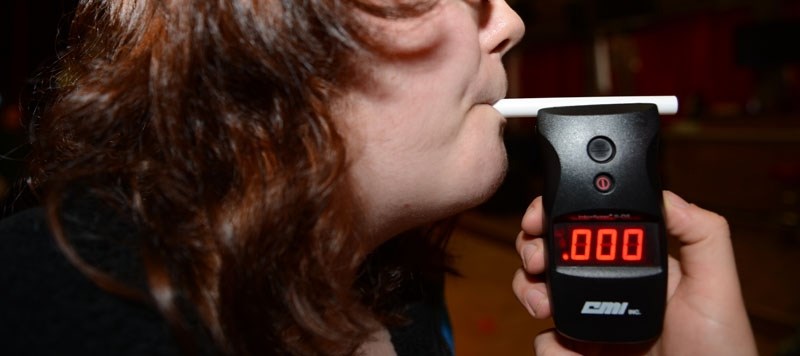Taking steps to address a drinking problem has saved a St. Albert woman from a criminal record.
The woman, who pleaded guilty to driving with a blood alcohol level over .08 in August, was handed a curative discharge last month.
Judge Bruce Garriock said he was satisfied that a curative discharge would be appropriate in this situation, despite a long list of aggravating circumstances: a dangerous driving pattern that involved hitting the median; almost hitting another motorist and prompting a civilian complaint; a lack of co-operation with police in having to be physically pulled from her vehicle; and aggravated blood-alcohol readings of 0.29 and 0.30, both more than triple the legal limit.
“Most people would be comatose or dead at that number,” Crown prosecutor Ewan Gilmour said. “It indicates quite a problem for (the woman) herself and the public.”
Nonetheless, he said he was satisfied a curative discharge would be in the best interests of both the woman and the general public after receiving correspondence from a doctor involved in the treatment that things were going well.
For her part, the woman said the incident was an opportunity to seek help for her addiction. She completed a three-month residential treatment program and continues to attend Alcoholics Anonymous every week.
“I’m taking this charge very seriously, and I understand I need to be in active recovery every day,” she said. “For the rest of my life.”
Curative discharges aren’t exactly common in Alberta but aren’t particularly rare either.
Robert Palser, a senior policy counsel with Alberta Justice and the traffic safety co-ordinator for the province, said that in 2014 there were 226 curative discharges granted in the province, which is around two per cent of a total of 9,760 people convicted of impaired driving or driving with a blood alcohol limit over .08. This does not include the number of people charged but never convicted.
He explained the provision, enacted by Parliament in 1985, requires several conditions be satisfied before a judge can grant such a discharge: the accused applies for the discharge, presents medical or other evidence indicating there is an addiction at play, the judge must be convinced there is a bona fide need for addictions treatment, and the judge is convinced that granting such a discharge would not be contrary to the public interest.
The public interest is not clearly defined in the Criminal Code or in case law, he added, but rather requires the judge to take into consideration factors like past criminal record, ability to comply with court orders and the likelihood of the accused reoffending.
“The judge is going to have to make this assessment of all those factors, and frankly anything else that arises out of the circumstances,” Palser said. “There may be something unique or special about the case.”
While Crown prosecutors are not typically for or against granting a curative discharge in any given case, they will raise all the appropriate issues relating to that determination of public interest.
“Our job is fundamentally to make sure it’s applied appropriately in the courts, and that decision is ultimately the judge’s,” he said.
Shannon Prithipaul, an Edmonton-based defence lawyer and past-president of the Alberta Criminal Trial Lawyers’ Association, has been practising law for nearly 15 years and often takes drunk-driving cases.
She said while the curative discharge is a tempting road for many clients, it’s not something that should be taken lightly.
“It’s way more effort,” she said. “It’s much easier to just plead guilty and get it over with. For a curative discharge you really need to work for it.”
For a first offence related to drunk driving, the sentence is typically a fine in the range of $1,000 to $1,500 and a one-year driving prohibition, depending on the circumstances.
By comparison, a curative discharge requires someone to spend years bound by relatively strict probation conditions relating to their treatment, and in some cases seeking such a lengthy period of probation could “set them up for failure.”
“If you’re under conditions, and they’re usually fairly onerous conditions for three years, you’d better be really dedicated,” Prithipaul said. “Otherwise there’s a good possibility that you could breach, and if you breach you could be brought back into court on new charges.”
While the cost of seeking such a discharge is typically fairly low, and is even something one could theoretically do without the help of a lawyer, one would typically need the advice of a lawyer to even know the possibility exists.
It’s not something a duty counsel or other Legal Aid lawyer would typically assist with.
“It doesn’t cost a lot, but it might still be enough that it prohibits some people from getting into it,” Prithipaul said.
From the perspective of both a prosecutor and a defence lawyer, this provision of the Criminal Code yields a net positive result for everyone involved including the general public in terms of safety on the roads.
“Anything, to be honest, that gets impaired drivers off the road not only helps them, but substantially improves public safety for everyone,” Palser said. “Any issues surrounding curative discharges have to recognize there’s a real value in having treatment programs in place.”
It’s a sentiment Prithipaul also expressed.
“If they work for it and get it at the end, then bravo for them because they’ve now benefitted themselves and society,” she said. “We’re all better off for it if these people can get rehabilitated.”




